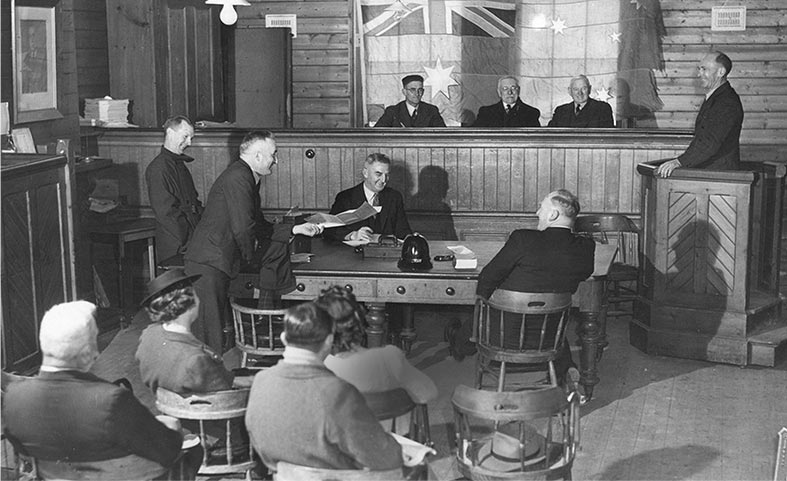Library and Archives Canada, formerly the Canadian National Archives, houses boxes of capital case files dating from 1867, the year of Confederation, to 1976, when Canada abandoned the death penalty. There are hundreds of files. When a defendant was convicted of murder or another capital crime, documents related to the case were forwarded to the Department of Justice in Ottawa, which determined whether the law should, as the euphemism went, ‘be allowed to take its course’ or whether a term of imprisonment would be substituted. The files have a rhythm. They usually begin at the end, with a government memo summarizing the defendant’s fate and listing the documents – trial transcript, correspondence, petitions, telegrams – that sealed it. Then the files snap back to the beginning, with the letter the trial judge invariably sent to the Minister of Justice containing his initial recommendation, urging mercy or a swift and confident hanging. Sometimes, especially while reading the thickest files or at the end of the longest library days, a reader might forget the opening memo and its conclusions, allowing the files’ original suspense to creep back in. Telegrams sent in triplicate to sheriffs, judges, and governors of distant territories requesting acknowledgment of an eleventh hour commutation order regain, briefly, their terrible urgency.


Working with the capital case files for my article, “Heart of Ice: Indigenous Defendants and Colonial Law in the Canadian North-West,” which complements my book project on criminal responsibility and homicide in the nineteenth-century British empire, got me thinking about time. The article considers the case of three Cree men, Charles Ducharme, Wawasehowein and Wahsahgamass, convicted in a Canadian colonial court of murdering Riskeyak, an elderly Cree woman. The killing happened in 1885 in the midst of the North-West Resistance, in which Métis and First Nations people rose against the colonial government. Riskeyak’s killing was not, by all indications, an act of war. In fact, almost everyone, both Cree and Euro-Canadian, seemed to agree that her death had nothing directly to do with the Resistance.
And yet, the fact that she died during the conflict, while her people fought Canadian troops and held white prisoners of war captive, inflected every aspect of the colonial case against her killers and how their story has been remembered. The judge in the case, Charles B. Rouleau, heard all of the cases of Indigenous people charged with murder in the wake of the Resistance. Rouleau’s Battleford court produced the death sentences that would result in the largest mass hanging in Canadian history. Eight Indigenous men were executed in the fall of 1885 for killings committed in wartime. If their sentences had not been commuted, two of Riskeyak’s killers would have joined them. The prosecutor in their case, William Prescott Sharpe, also represented the Crown in the Battleford cases against First Nations rebels. Even years after the Resistance, government officials continued to describe Riskeyak’s killers as ‘rebels’ and to link them to their schemes for post-Resistance pacification. In 1888, in one indicative example, high-ranking members of the Department of Indian Affairs referred to Ducharme, Wawasehowein and Wahsahgamass, then languishing in prison, as “the three rebel Indians.” The timing and circumstances of Riskeyak’s death wove her story into the fabric of the Resistance, but not seamlessly. In the eyes of the colonial state, her killers were both rebels and non-rebels, their violence both political and apolitical.

Riskeyak’s death became part of the Resistance, but never identical with it, for the simple reason that it happened at the same time. It seemed clear to me, on first encountering the capital case file, that her killing should be distinguished from those committed by white and Indigenous soldiers as they captured forts or seized materiel. Simultaneity isn’t destiny, although it certainly matters.
It took me longer than I care to admit to appreciate how the capital case file – which I knew reflected the priorities and ideology of the colonial state – had shaped my understanding of the chronology of Riskeyak’s story. I was too quick to see her death as the beginning of ‘the case,’ the event that caused the law to creak into action. At first, for me, her killing was the thing that led to the trial that prompted Rouleau to write to the Minister of Justice, triggering the creation of the file. As I started reading more work by Indigenous scholars, however, I saw that I got the timing wrong. Riskeyak’s death might have initiated the colonial legal process, but it also represented the end of a Cree legal process. There were two cases in the file, not one.
The colonial archives, as they always do, provide asymmetric and incomplete information about the Indigenous law that governed Riskeyak’s case. Still, there were hints. For instance, Sharpe, the prosecutor, explained in a letter to Ottawa that the Cree believed that Riskeyak was a ‘witigo’ (wendigo), a “crazy person desirous of eating human flesh” who “to gratify this craving…was supposed to be capable of killing” and who was “supposed to have some extraordinary powers of resurrection.” Killing her, argued Sharpe, was a public service. Riskeyak’s death was a judicial execution, which her killers agreed to perform in the face of considerable danger. An 1887 petition signed by members of a First Nations community near where Riskeyak died reiterated the point.


Legal historians, colonial historians, and historians of colonial law know to approach case files with skepticism, to read creatively, and to look for pluralism. However, the narrative coherence, drama and predictability of case files can dull these impulses. For me, thinking about how the archive imposes a sense of when a case began, when a series of events first became ‘legal,’ helps to sharpen them.
Catherine Evans is Assistant Professor at the Centre for Criminology and Sociolegal Studies of the University of Toronto
Link to author faculty page: http://criminology.utoronto.ca/facultyandstaff/faculty-2/faculty/catherine-evans/


